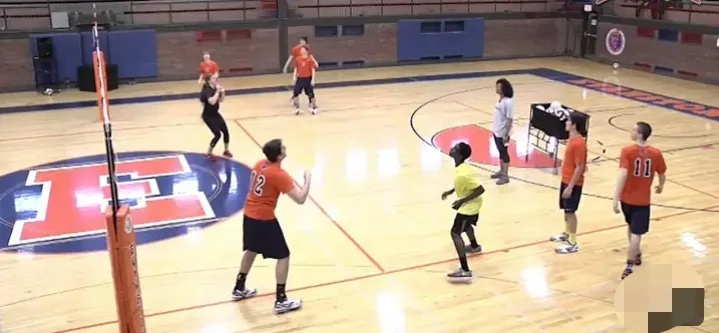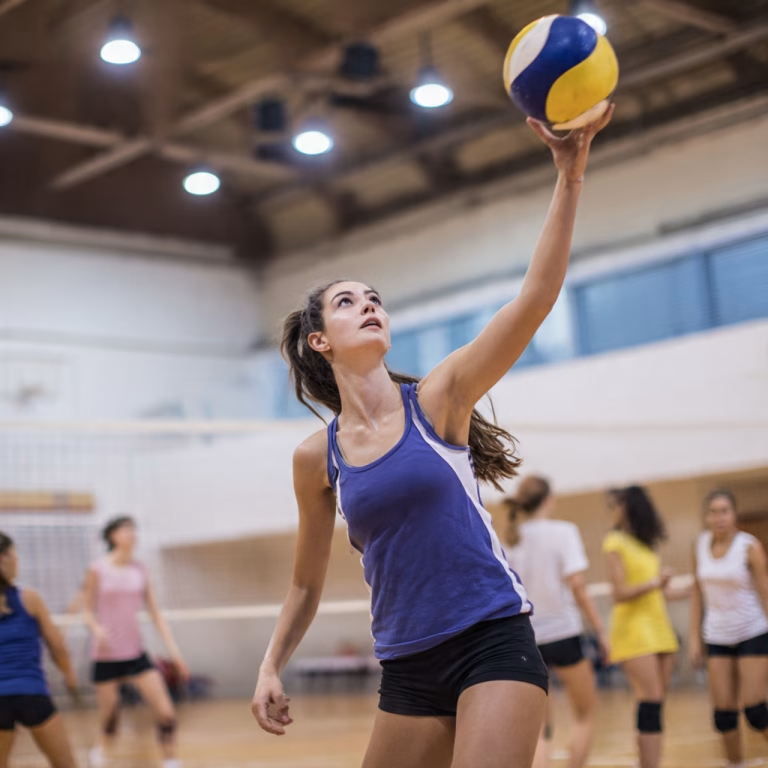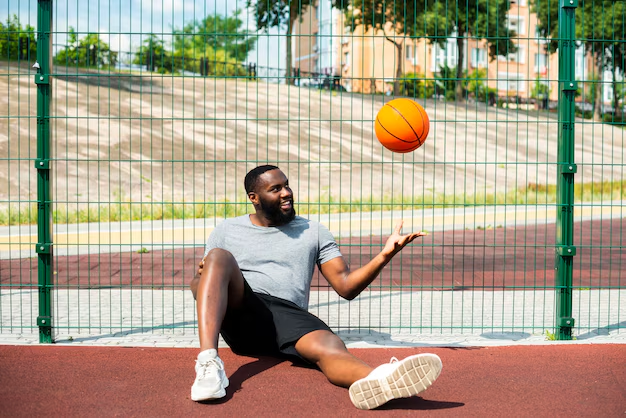Volleyball drills for high school boys are important drills in developing basic volleyball skills, enhancing teamwork, and preparing them for competitive matches. Whether you are a beginner or an experienced player, these drills build core abilities such as passing, spiking, serving, and defense, all of which are essential for success on the court.
In this article, we will break down some of the best volleyball drills for high school boys, helping both coaches and players optimize their practice sessions for maximum results.
See Also: 8 Best Drills to Do at Volleyball Tryouts
Why volleyball drills matter for high school boys
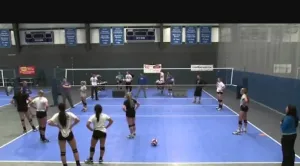
Drills provide structure and focus to volleyball training. For high school boys, these exercises offer a foundation for mastering the fundamentals while pushing them to improve their technique and teamwork. Whether it’s learning how to spike accurately or block effectively, drills create a pathway toward success on the court.
Let’s get started with specific drills that can make a big difference for high school volleyball players.
Volleyball Drills for High School Boys
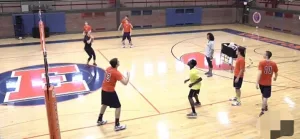
1. Warm-up Drills
Before any game or practice session, it’s important to get the body moving and ready for action. Here are some excellent warm-up drills for high school boys:
- Dynamic Stretching: This involves moving the muscles through their full range of motion to increase blood flow and flexibility. It prepares players for more intense activity, reducing the risk of injury.
- High Knees and Butt Kicks: These exercises warm up the legs and improve foot coordination, which is essential for quick movements on the court. For example, high knees can simulate the quick footwork needed for effective blocking or transitioning from defense to attack.
See Also: 10 Best Volleyball Strength Exercises for Beginners
2. Communication Drills
Communication is critical for success in volleyball, and each drill has a communication element. High school players can work on communication skills through two versions of a drill:
- Game Play Communication: Play a regular 6-on-6 game. Each player must call out the name of the opponent they are hitting the ball toward.
- Limited Speaker Drill: The coach calls out one player from each team, and only those players can talk. The coach eventually gives every player a turn to speak. This encourages everyone to practice communication.
3. Passing Drills
Passing is the foundation of any volleyball game. Without good passing skills, it’s hard to set up a successful attack.
- Partner Passing: In this drill, players pair up and pass the ball to each other. The goal is to focus on controlling the ball and making clean, accurate passes. High school boys can do this drill for a set number of passes or time, improving ball control under pressure.
- Triangle Passing Drill: Three players form a triangle and pass the ball to each other in random order. This drill emphasizes footwork and communication, teaching players how to adjust quickly to unpredictable situations, much like they would in a real match.
- Bump, Set, Send Drills: This is a control drill, ideal for warming up before a game or practice. How to: Each player pairs up with a partner. Player 1 bumps the ball to themselves, then sets it to themselves, and finally hits it to their partner. The partner digs the ball and repeats the process.
4. Volleyball Drills for High School Boys: Setting Drills
Setting is another critical skill that high school boys need to perfect for successful plays.
- Wall Setting Drill: Players stand a few feet away from a wall and repeatedly set the ball against it. This helps improve hand placement and touch, crucial for accurate sets during a game. High school boys can do this individually, which makes it a great drill for extra practice at home.
- Back Row Setting Drill: This drill teaches players how to set from different positions on the court. It’s especially helpful for setters who need to deliver accurate sets from the back row, simulating real-game scenarios.
5. Serving, spiking, and blocking drills
Serving, spiking, and blocking are often the most exciting parts of volleyball. But mastering these skills requires targeted drills.
- Target Serving Drill: High school boys can practice their serving accuracy by aiming for specific zones on the court. Coaches can place cones or other markers to challenge players to hit different areas. This drill is great for improving consistency and pressure-serving in game situations.
- Approach and Jump Spiking Drill: Players practice their spiking approach, focusing on timing their jump with the set. High school boys can perform this drill with a setter or with the help of a coach. The goal is to improve timing, power, and precision.
- One-on-One Blocking Drill: In this drill, a blocker faces a spiker, simulating a real-game scenario. It helps high school boys learn the proper timing and hand placement needed to block an attack effectively. This drill also sharpens the reflexes needed to react to quick spikes.
6. Serve and Receive Drills
This drill works on passing and receiving:
- Two teams of six players stand on either side of the net.
- Three players from the back row pass, one player is the target, and two serve.
- Each team takes turns serving.
- The passer sends the ball to the target, who must remain at the center of the net.
- When the target catches the ball, the passer switches places with the target, and the target serves next.
- If a passer fails to pass to the target, the target and server rotate positions.
7. Black Sheep drills
This drill enhances serving and receiving using a designated passer:
- Two teams of six are set up in regular game positions.
- One player wears a different colored jersey. This player is the only one allowed to make the first pass after the serve.
- The rest of the team adjusts to this setup.
- To make it more challenging, set a 2-minute timer.
8. Footwork Drills
These drills focus on improving foot movement.
Shuffle Pass:
- Partners face each other. Partner A stands on the serving line, and Partner B stands on the 10-foot line.
- Partner A tosses the ball to the left; Partner B shuffles to the left and passes it back.
- Partner A then tosses the ball to the right; Partner B shuffles right and passes it back.
- Repeat 10 times per side, then switch roles.
Toe Touch:
- Partners stay in the same positions.
- Partner A tosses the ball short (around 3 feet).
- Partner B runs forward from the serving line to pass the ball, then touches Partner A’s toe to stay low.
- Partner A then tosses the ball deep, and Partner B backpedals to make a successful pass.
- Repeat 10 short and deep passes, then rotate.
9. Defensive and Game-Like Volleyball Drills for High School Boys
Defense is often the unsung hero of volleyball, but it’s just as important as the offense. Here are some drills that focus on defensive skills:
- Digging Drill: This drill teaches players to dive and save low balls. High school boys can practice by having coaches or teammates hit balls at different speeds and angles, helping them improve their reaction time and technique.
- King of the Court Drill: This competitive drill can be played with teams of three or four players. One team remains on the court until they are beaten by another team. It’s a fast-paced and fun way to put all volleyball skills into practice while encouraging team spirit.
FAQs
1. What are some essential volleyball drills for high school boys?
Essential volleyball drills for high school boys include warm-up drills like dynamic stretching, passing drills such as partner passing and triangle passing, and more advanced drills like spiking and blocking drills. Serving drills, such as target serving, and game-like scrimmages like “King of the Court,” help players improve both their technique and teamwork.
2. How often should high school boys practice volleyball drills?
High school boys should practice volleyball drills at least 3-4 times a week for optimal improvement. However, balance is key—mixing skill drills with strength training and recovery helps avoid burnout and injuries. Consistency and focus during each practice session are essential for getting the best results.
3. What are good beginner volleyball drills for high school boys?
Good beginner drills include partner passing, wall setting, and digging drills. These basic exercises help develop foundational skills, such as ball control, hand placement, and defensive reactions. As players progress, they can transition into more advanced drills, like spiking and blocking.
4. How can high school boys improve their volleyball skills outside of practice?
Outside of regular practice, high school boys can work on their skills by practicing against a wall, focusing on exercises that improve vertical jump, or doing drills like wall setting at home. Watching volleyball matches and analyzing professional players’ techniques can also provide insights into better gameplay.
Conclusion
By regularly practicing these volleyball drills for high school boys, young athletes can sharpen their skills, improve their performance, and build stronger teamwork. Whether it’s learning to serve with accuracy or mastering the art of spinning, drills provide the repetition and focus needed to excel in volleyball.

